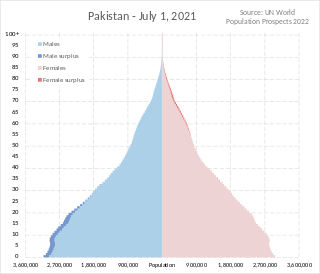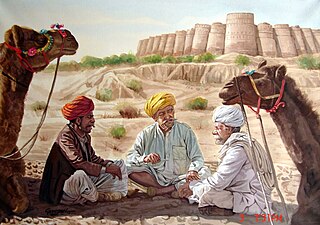
Pakistan had a population of 241,492,197 according to the final results of the 2023 Census. This figure includes Pakistan's four provinces e.g. Punjab, Sindh, KPK, Balochistan and Islamabad Capital Territory. AJK and Gilgit-Baltistan's census data is yet to be approved by CCI Council of Pakistan. Pakistan is the world's fifth most populous country.

The Baloch or Baluch are a nomadic, pastoral, ethnic group which speaks the Western Iranic Baloch language and is native to the Balochistan region of South and Western Asia, encompassing the countries of Pakistan, Iran, and Afghanistan. There are also Baloch diaspora communities in neighbouring regions, including in Central Asia, and the Arabian Peninsula.

Pakistan is a multilingual country with over 70 languages spoken as first languages. The majority of Pakistan's languages belong to the Indo-Iranian group of the Indo-European language family.

Hyderabad is a city and the capital of Hyderabad Division in the Sindh province of Pakistan. It is the second-largest city in Sindh, and the fifth largest in Pakistan.
The Laṇḍā scripts, is a Punjabi word used to refer to writing systems used in Punjab and nearby parts of North India. In Sindhi, it was known as 'Waniko' or 'Baniyañ'. It is distinct from the Lahnda language varieties, which used to be called Western Punjabi.
South Asian ethnic groups are an ethnolinguistic grouping of the diverse populations of South Asia, including the nations of Bangladesh, Bhutan, India, Maldives, Nepal, Pakistan, and Sri Lanka. While Afghanistan is variously considered to be a part of both Central Asia and South Asia, Afghans are generally not included among South Asians.
Pashtun diaspora comprises all ethnic Pashtuns. There are millions of Pashtuns who are living outside of their traditional homeland of Pashtunistan, a historic region that is today situated over parts of Afghanistan and Pakistan. While the (erstwhile) Pashtunistan is home to the majority of Pashtun people, there are significant local Pashtun diaspora communities scattered across the neighbouring Pakistani provinces of Sindh and Punjab, particularly in their respective provincial capital cities of Karachi and Lahore. Additionally, people with Pashtun ancestry are also found across India; particularly in Rohilkhand, a region in the Indian state of Uttar Pradesh; and in the Indian states of Gujarat and Rajasthan. Outside of South Asia, significant Pashtun diaspora communities are found in the Arab states of the Persian Gulf, the United States, the United Kingdom, Germany, Iran, Australia, Canada, and Russia.
Pakistani clothing refers to the ethnic clothing that is typically worn by people in the country of Pakistan and by Pakistanis. Pakistani clothes express the culture of Pakistan, the demographics of Pakistan, and cultures from Punjab, Sindh, Balochistan, Khyber Pakhtunkhwa, Gilgit-Baltistan, and Kashmir regions of the country. The clothing in each region and culture of Pakistan reflect weather conditions, way of living, the textiles and embroidery used and its distinctive style which gives it a unique identity among all cultures.

Khetrānī, or Khetranki, is an Indo-Aryan language of north-eastern Balochistan. It is spoken by the majority of the Khetrans, an ethnolinguistic tribe that occupies a hilly tract in the Sulaiman Mountains comprising the whole of Barkhan District as well as small parts of neighbouring Kohlu District to the south-west, and Musakhel District to the north. The ethnic Khetran population found to the east in the Vehova Tehsil of Taunsa Sharif District of Punjab instead speak Saraiki. Alternative names for the language attested at the start of the 20th century are Barāzai and Jāfaraki.
Jat Muslim or Musalman Jat, also spelled Jatt or Jutt, are an elastic and diverse ethno-social subgroup of the Jat people, who are composed of followers of Islam and are native to the northern regions of the Indian subcontinent. They are found primarily throughout the Sindh and Punjab regions of Pakistan. Jats began converting to Islam from the early Middle Ages onward and constitute a distinct subgroup within the diverse community of Jat people.
The Baloch diaspora refers to Baloch people, and their descendants, who have immigrated to places outside the Balochistan region of South-West Asia – a region stretching from southwestern Pakistan to southeastern Iran and southern Afghanistan. The Baloch diaspora is found throughout the Middle East, South Asia, Turkmenistan, East Africa, Europe, North America and in other parts of the world.
There are or have been a number of separatist movements in Pakistan based on ethnic and regional nationalism, that have agitated for independence, and sometimes fighting the Pakistan state at various times during its history. As in many other countries, tension arises from the perception of minority/less powerful ethnic groups that other ethnicities dominate the politics and economics of the country to the detriment of those with less power and money. The government of Pakistan has attempted to subdue these separatist movements.
The Balochs of Punjab are a community of Saraiki and Punjabi-speaking Baloch tribes settled in the Punjab province of Pakistan. The majority of Baloch in southern Punjab, including Dera Ghazi Khan and Rajanpur, which adjoin the province of Balochistan, identify as "Saraikis" or "Saraiki Balochs" and natively speak Saraiki, while a minority still speaks Balochi. However, in central and northern Punjab, the people of Baloch descent identify as "Punjabis" or "Punjabi Balochs" and natively speak Punjabi.

The Saraikis, are a Indo-Aryan ethnolinguistic group native to the Southwestern region of the Punjab province of Pakistan. They are multi-ethnic in origin and speak the Saraiki language.
The ethnic groups in Karachi includes all the ethnic groups in Pakistan. Karachi's inhabitants, locally known as Karachiwala, are composed of ethno-linguistic groups from all parts of Pakistan, as well as migrants from South Asia, making the city's population a diverse melting pot. At the end of the 19th century, the population of the city was about 105,000, with a gradual increase over the next few decades, reaching more than 400,000 on the eve of independence. Estimates of the population range from 15 to 18 million, of which an estimated 30% are migrants from different backgrounds. The city's population is estimated to be growing at about 5% per year, including an estimated 45,000 migrant workers coming to the city every month from different parts of Pakistan.
The Baluch is a Muslim community found in the state of Uttar Pradesh, India. They are descended from Baloch tribesmen who settled in this region of North India in the late Middle Ages. The community use the surname Khan, and are often known as Khan Baloch

Pakistanis are the citizens and nationals of the Islamic Republic of Pakistan. According to the 2017 Pakistani census, the population of Pakistan stood at over 213 million people, making it the world's fifth-most populous country. The majority of Pakistanis natively speak languages belonging to the Indo-Iranic family.

Targeted killings in Pakistan have been a rising form of violence and have contributed to security instability in the country. They have become common and have gained attention especially in Karachi, Pakistan's largest city, economic capital and capital city of the Sindh province. Several targeted killings have also occurred in Quetta, the capital of the southern province of Balochistan. Police and law enforcement agencies have sometimes come under criticism for their ineffectiveness in locating the perpetrators and investigating their motives. For most part, targeted killings in Karachi have been attributed to political, religious and ethnic reasons. There are speculations about the killing but no real proof has been found against any party.

Bandhi is a town of Shaheed Benazir Abad District of Sindh, Pakistan. Its population is over 40,000.
The Sindhis of Balochistan are an indigenous Sindhi population living in Balochistan, Pakistan.










